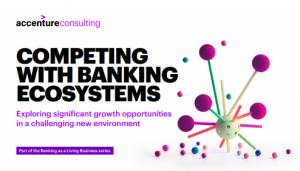Other parts of this series:
As digital disruption and slowing growth continue to characterize the global banking landscape, many banks are taking an increasing interest in ecosystems.
Yet it is not only the “pull” of growth and new revenue sources that is attracting banks to ecosystems. There are at least four “push” factors also at play: customers are beginning to demand ecosystem-enabled functions from all of their service providers; open banking initiatives are gaining momentum; banking technology is increasingly ecosystem-friendly; and the number of willing partners is growing, creating incentives for banks to secure strategic relationships.

Add it all up and you get an industry-wide zeal for ecosystems. Indeed, an Accenture Research global survey of banking executives found that 89 percent think that ecosystem-related initiatives will be the main driver of future value creation in the industry.
So how, exactly, might that work? Ecosystems are tremendously flexible tools—in fact, this is a major part of their appeal. But in the world of banking there are three principle ways they can create value.
1. Boosting cross-selling and growing primary relationships
Business ecosystems are a great way to provide hyper-relevant experiences for current customers. This creates opportunities to grow the value of extended relationships with other financial products and increase cross-selling. A simple example: offering mortgage holders a consumer loan for home appliances through an ecosystem partner. Nearly all of the 120 banks we surveyed for our ecosystem research are seeking to grow their customer relationships in this way in the next three years.
2. Reducing customer churn with “sticky” new offerings
Creating or joining third-party ecosystems gives banks many chances to deliver more meaningful customer experiences, and to follow customers beyond the boundaries of traditional relationships.
For example, BBVA has developed a property management ecosystem called Valora (“value” in English). Valora helps customers understand the property market at a glance, so they can more easily make a smart decision about buying or renting a home. This much one might expect from a bank, but Valora goes further. It helps users manage expenses, access insurance and mortgage information, and plan for renovations and appliance purchases.
Our research indicates that global banks expect programs like this one to reduce customer churn rate by up to 10 percent over the next three years.
3. Generating new revenue streams through partnerships
The growth of Google and Facebook from small startups to some of the most successful businesses in history demonstrates the value of user data. Ecosystems allow banks to make similar plays by offering partners access to customer data in exchange for fees. (This must be done with robust information security and clear consent from customers, of course.)
Other possible new sources of revenue enabled by ecosystems include first mover’s advantages that can accrue from orchestrating the system and other fees for opening banking infrastructure to partners.
Accenture research indicates that, over the next three years, most banks expect more than 10 percent of their incremental revenues to be generated by ecosystem plays.
These three sources of value can be applied to a wide range of industries and applications. Our research indicates that the three most popular areas of focus for ecosystem plays among banks right now are:
- Business services. Fifty-eight percent of surveyed banks are targeting business services with their ecosystem strategy—things like legal services, website creation, online marketing and promotion, e-invoicing and payment services, and regulatory reporting.
- Housing. Thirty-eight percent of surveyed banks are focusing on housing—that means services like house-hunting aides, maintenance checks and discounts, home security, tenant screening, and storage services.
- Wealth. Thirty-eight percent of surveyed banks are targeting wealth with their ecosystem strategies. That can include services like budgeting, international money transfers, and bill comparisons.
These are the three most popular focus areas revealed in our ecosystems research, but it’s important to note that ecosystems can reach further still. Some banks report that their ecosystem targets include public services (think paying fines, checking credit history, registering companies, or tax services), mobility, and health. The range of these targets underscores the flexibility of ecosystems—and their capacity to help banks innovate.
Of course, that flexibility can make it tough to know where to start for those still sizing up the ecosystem opportunity. Come back next week for my final post in this series, which will look at setting up ecosystem plays.
In the meantime, you can review the full report on our ecosystem research.











